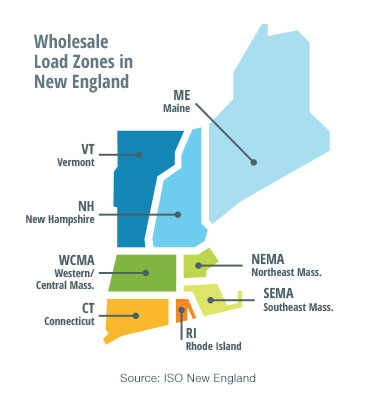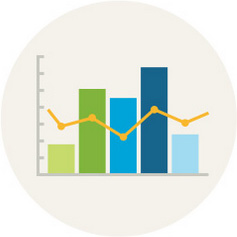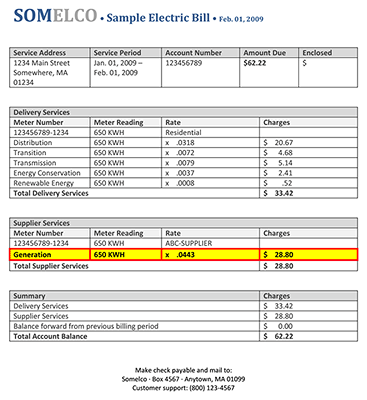Like most commodities, electricity is first produced and sold on the wholesale level before it is sold and distributed to consumers on the retail level. In New England, wholesale electricity is bought and sold two ways: through contracts and markets.
The prices established for the following wholesale market products and services together make up the overall market-based cost of wholesale electricity.
The core product bought and sold in the markets is electrical energy. Power plants generate electricity and sell it into the energy market. “Load servers” or “suppliers” buy the electricity wholesale in the marketplace and supply it to retail consumers. This is the electricity that you buy from your local utility or independent supplier and use at your home or business. If you live in a state that has restructured its electricity market (Connecticut, Maine, Massachusetts, New Hampshire, or Rhode Island) you are eligible to purchase power directly from a supplier. If you have not chosen a competitive supplier, your utility purchases electricity on your behalf.
The energy market produces a price for wholesale electricity every hour of every day during the year at defined locations across the New England power system.

The price of wholesale electricity fluctuates throughout the hours of the day, seasons of the year, and at the different locations in New England due to many factors. Some of the largest factors influencing price are:
The wholesale electricity price in any hour reflects the cost of generating electricity and delivering it over the high-voltage transmission system, and fluctuates depending on the system conditions. The largest portion of the wholesale cost is the energy price.
Several other wholesale electricity products are transacted through wholesale markets. These products ensure the reliability of the power system, meaning that the lights stay on in both the short- and long-term.
By rule, load servers and suppliers must purchase these products, along with the energy.

As the administrator of these markets, ISO New England is responsible for the settlement process, which includes billing and collecting payments from wholesale electricity buyers and forwarding the payments to sellers.
The ISO is a not-for-profit organization. To fund its operation, it charges a small fee to buyers and sellers in the wholesale markets for each transaction that the ISO handles on their behalf. This fee is determined by a federally regulated tariff.
The wholesale market costs described above (incurred by your load server or supplier) are reflected in your electricity bill as a cents per kilowatt hour (kWh) charge, often called “basic service” or “default service.”

Under this section of your bill, wholesale market energy and reliability costs are bundled with other costs from your supplier. These other costs can include the cost of contracts for electricity purchased from generators or other suppliers, premiums the supplier charges for shielding you and others from wholesale cost volatility, administrative costs, and profit. The way these charges appear on your bill varies by state and jurisdiction.
You’ll also notice that your electricity bill includes transmission, distribution, transition, and other charges approved by your state. These charges are typically listed under “delivery” charges and are paid to your local electric company to fund the operation and maintenance of the distribution system (including the wires, poles, and meters that bring electricity to your home or business), and other costs associated with state-level electricity restructuring and public policy initiatives.
Wholesale electricity costs are paid for by market participants that purchase electricity from the wholesale market for either their own use, or because they are a supplier to retail consumers. In turn, suppliers and utilities provide electricity to retail consumers based on the retail market structures and requirements of the six New England states. Utilities charge retail consumers for power supply through their monthly bills; these rates are approved by the state through their public utility commissions.
The relationship between wholesale market costs and retail rates varies according to state retail procurement policies. In particular, prices from the short-term wholesale markets are very different from the fixed prices of the supplier services that are provided to residential consumers, which tend to be fixed over a longer period. Retail markets have several different customer classes, such as industrial and commercial, and market pricing for these consumers may be very different from residential customer pricing.
You can read about the components that make up wholesale electricity costs in more detail in the ISO’s monthly Wholesale Load Cost Report.